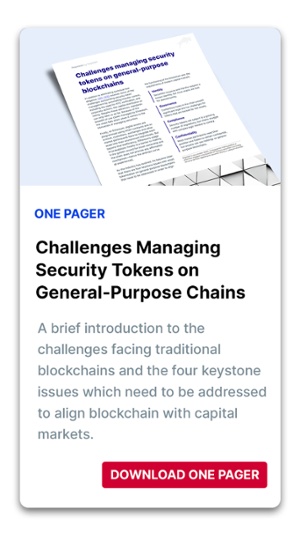Regulation dictates that securities must be associated with an identity. However, general-purpose blockchains were built for censorship resistance and pseudo-anonymity. This ethos makes it very difficult to meet compliance requirements around identity verification and to fulfill Know-Your- Customer (KYC) obligations.
By contrast, Polymesh uses a customer due diligence process to ensure all actors on the chain are verified. Polymesh streamlines this process by creating a single identity on the chain for each real-world individual or organization and then attaches attestations to their identity as needed. This modular two-stage approach to identity verification allows for efficient onboarding as well as specific checks.
#2 - Compliance
Security tokens are subject to a myriad of regulations and we expect these to grow in number and complexity, but general-purpose blockchains struggle with the complex logic needed to comply. Proprietary solutions can be built on top of the chain and while these layer 2 applications can automate key steps, as users begin to layer on successive rules, the number and complexity can push the chain to its computational limits. This drives up costs and processing time.
In comparison, Polymesh gives issuers the flexibility to set rules around ownership and transfer requirements based on their specific needs. Once the issuer inputs preferences and restrictions, Polymath’s technology automates its enforcement. Because this functionality is built into the core of the chain rather than as an add-on, even very complex compliance requirements can be automated efficiently (and cost-effectively) at scale.
Security tokens are subject to a myriad of regulations and we expect these to grow in number and complexity, but general-purpose blockchains struggle with the complex logic needed to comply.
#3 - Confidentiality
Capital market participants value confidentiality and privacy. Financial institutions must protect client information to comply with privacy requirements and safeguard their own financial interests. Non-reporting entities, usually with a small pool of shareholders, often do not want any ownership or transfer information to become public. On general-purpose blockchains, layer 2 solutions can be used to make transactions and balances confidential, but to add transaction privacy, they must sacrifice the ability to automate compliance checks or ownership reporting.
Because Polymesh is intended for securities, it makes it possible to transfer and hold assets confidentially, while still automating compliance checks and cap table updates. This is done through MERCAT, a new patent-pending protocol for securely managing assets in a confidential and auditable way. MERCAT uses a hybrid design approach that combines zero-knowledge proofs with restrictions enforced by trusted mediators, giving issuers the option to make transactions with their security token confidential during configuration.
#4 - Governance
Governance is a difficult topic for any blockchain, but this is especially true for security tokens, where the chain is not only the source of truth for potentially billions of dollars, but must also allow investors, issuers, and capital market participants to fulfill their regulatory obligations. Because of its decentralised nature, when there is a disagreement, a blockchain can be split into two separate chains, known as a fork, which can expose major legal and tax challenges for security tokens.
Polymesh addresses the challenges general-purpose blockchains face with governance by building it into the core of the blockchain. Normally, blockchains are susceptible to forks during upgrades. Polymesh is built on Substrate Framework, which provides Forkless Runtime Upgrades. This allows for seamless upgrades on the chain to avoid the risk of hard forks. In addition, Polymesh relies on a council of key stakeholders to review Polymesh Improvement Proposals submitted by committees or token holders, find a consensus, and chart a path forward for its future development. This provides a means of steering the chain past potential issues or disagreements.
#5 - Finality
For the blockchain to contain a true representation of ownership, it must provide deterministic finality. Between Ethereum’s probabilistic finality mechanism, cumbersome compliance automation, and the unknown identity of block authors, it is not possible for it to serve as a golden record for asset ownership.
In essence, settlement finality is possible on Polymesh because of how identity, compliance, and governance are woven together in the core of the chain.
Alternatively, by creating assets at the protocol layer, Polymesh is able to provide a simplified approach to transfers and deterministic finality. It reduces delivery failure without requiring prefunding and can provide deterministic transaction finality through the GRANDPA finality gadget, as well as stringent identity verification requirements, a comprehensive compliance validation framework, and a forkless upgrade process. In essence, settlement finality is possible on Polymesh because of how identity, compliance, and governance are woven together in the core of the chain.
Read this guide on making blockchain work for capital markets to learn more.


